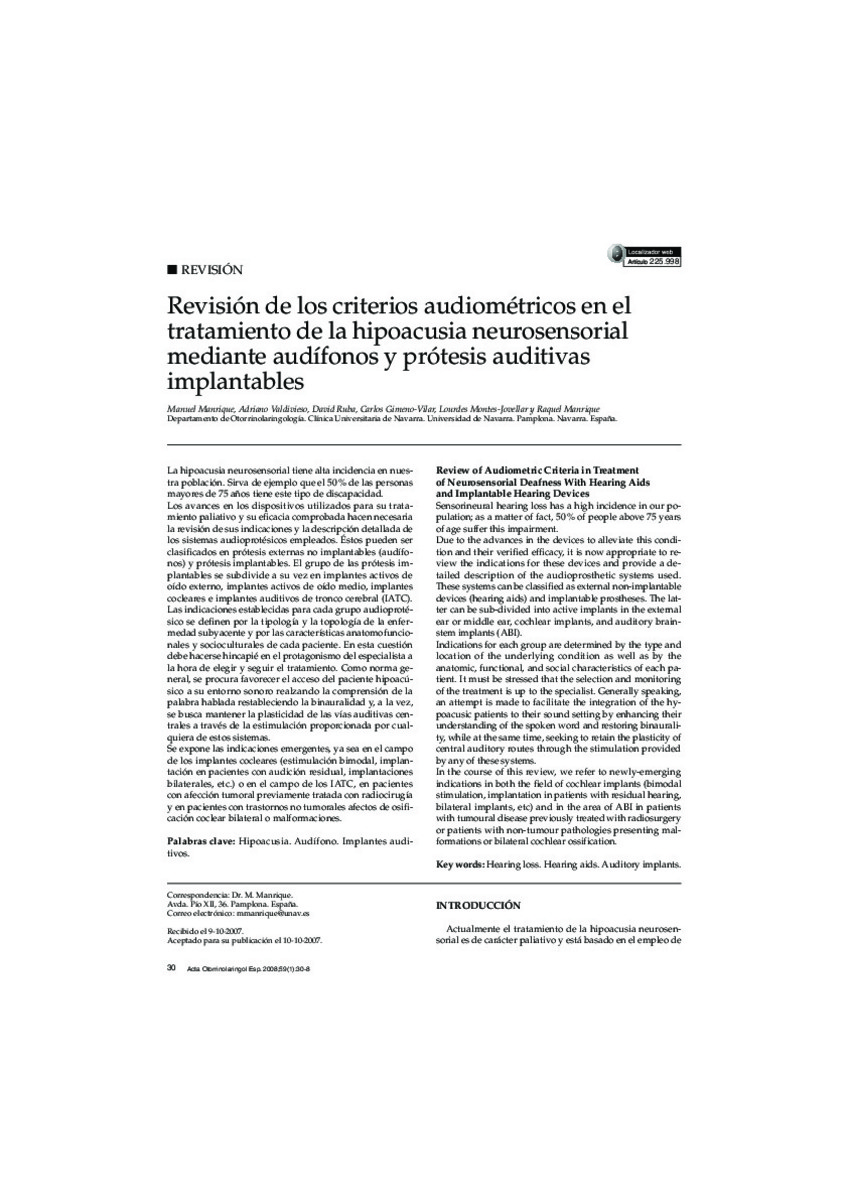Full metadata record
| DC Field | Value | Language |
|---|---|---|
| dc.creator | Manrique, M. (Manuel) | - |
| dc.creator | Valdivieso, A. (Adriano) | - |
| dc.creator | Ruba, D. (David) | - |
| dc.creator | Gimeno-Vilar, C. (Carlos) | - |
| dc.creator | Montes-Jovellar, L. (Lourdes) | - |
| dc.creator | Raquel | - |
| dc.date.accessioned | 2012-06-15T11:21:50Z | - |
| dc.date.available | 2012-06-15T11:21:50Z | - |
| dc.date.issued | 2008 | - |
| dc.identifier.citation | Manrique M, Valdivieso A, Ruba D, Gimeno-Vilar C, Montes-Jovellar L, Manrique R. Revisión de los criterios audiométricos en el tratamiento de la hipoacusia neurosensorial mediante audífonos y prótesis auditivas implantables. Acta Otorrinolaringol Esp 2008 Jan;59(1):30-38 | es_ES |
| dc.identifier.issn | 0001-6519 | - |
| dc.identifier.uri | https://hdl.handle.net/10171/22565 | - |
| dc.description.abstract | Sensorineural hearing loss has a high incidence in our population; as a matter of fact, 50 % of people above 75 years of age suffer this impairment. Due to the advances in the devices to alleviate this condition and their verified efficacy, it is now appropriate to review the indications for these devices and provide a detailed description of the audioprosthetic systems used. These systems can be classified as external non-implantable devices (hearing aids) and implantable prostheses. The latter can be sub-divided into active implants in the external ear or middle ear, cochlear implants, and auditory brainstem implants (ABI). Indications for each group are determined by the type and location of the underlying condition as well as by the anatomic, functional, and social characteristics of each patient. It must be stressed that the selection and monitoring of the treatment is up to the specialist. Generally speaking, an attempt is made to facilitate the integration of the hypoacusic patients to their sound setting by enhancing their understanding of the spoken word and restoring binaurality, while at the same time, seeking to retain the plasticity of central auditory routes through the stimulation provided by any of these systems. In the course of this review, we refer to newly-emerging indications in both the field of cochlear implants (bimodal stimulation, implantation in patients with residual hearing, bilateral implants, etc) and in the area of ABI in patients with tumoural disease previously treated with radiosurgery or patients with non-tumour pathologies presenting malformations or bilateral cochlear ossification. | es_ES |
| dc.language.iso | spa | es_ES |
| dc.publisher | Elsevier | es_ES |
| dc.rights | info:eu-repo/semantics/openAccess | es_ES |
| dc.subject | Hearing loss | es_ES |
| dc.subject | Hearing aids | es_ES |
| dc.subject | Auditory implants | es_ES |
| dc.title | Revisión de los criterios audiométricos en el tratamiento de la hipoacusia neurosensorial mediante audífonos y prótesis auditivas implantables | es_ES |
| dc.title.alternative | Review of audiometric criteria in treatment of neurosensorial deafness with hearing aids and implantable hearing devices | es_ES |
| dc.type | info:eu-repo/semantics/article | es_ES |
| dc.type.driver | info:eu-repo/semantics/article | es_ES |
| dc.identifier.doi | http://dx.doi.org/10.1016/S0001-6519(08)73254-0 | es_ES |
Files in This Item:
Statistics and impact
Items in Dadun are protected by copyright, with all rights reserved, unless otherwise indicated.






